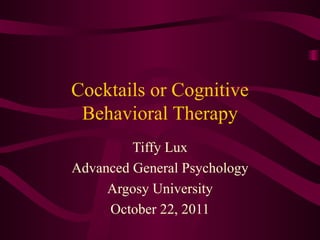
Cocktails or Cognitive Behavioral Therapy Presentation
- 1. Cocktails or Cognitive Behavioral Therapy Tiffy Lux Advanced General Psychology Argosy University October 22, 2011
Notes de l'éditeur
- Young children are being diagnosed with bipolar disorder at an alarming rate. This disorder was once thought to be rare in children and adolescents and now has increased 40 fold (Baroni, Lunsford, Luckenbaugh, Towbin, & Leibenluft, 2009). The children are being medicated with various cocktails of drugs, most of which show to be addicting. Not only are the children being constantly medicated, but the length of time it takes to determine whether the person is responding well to the medicine can take up to six weeks; at that time, if the medicine is not doing what it is supposed to, then the client is back at square one trying another cocktail. Instead of constantly dosing up children with various psychiatric medicines that have not been clinically tested on children, a new outlet needs to be considered. Cognitive Behavioral Therapy may just be the right answer for children and adolescents.
- CBT will focus on psychoeducation that will entail knowledge about the disorder, the pharmacological treatments, and the correlation between environmental factors with the client’s behaviors and cognition (Basco, Ladd, Myers & Tyler, 2007). n addition, the psychoeducation will include helping the clients develop a plan to notice the early warning signs that depression and/or mania symptoms and the ability to respond ahead of time (Basco et al., 2007). The third focus of CBT for BD clients is the actual improvement of behaviors, lifestyle modifications and adherence to the pharmacological treatments (Basco et al., 2007) The focuses of CBT in pediatric BD clients can prove to be difficult at the same level of adults. When considering pediatric clients, it will be imperative to tailor the CBT to a pediatric development level. Pediatric clients will not be as responsive to the wealth of information that would be presented in comparison to adult clients.
- Considering that living with BD is a lifetime illness, that means that the child will be on psychoactive drugs from the age of a young child until death, which alone will cause developmental neurotoxicity, suppression and distortion of the brain (Breggin, 2008). The benefits/risks that may result from the use of the psychoactive drugs for pediatrics is not the same that will be seen in adults. The body of a child is not developed at the same level as an adult (physically, neurologically, and psychologically). An investigative article that was conducted revealed that physicians and psychiatrists are aware that the brain of a child is undergoing extraordinary changes and there is no information regarding long-term impact of treatment on children when prescribing psychoactive drugs (Sharav, 2005). For example, a psychoactive drug will be prescribed, the patient will stay on the psychoactive drug for 4-6 weeks and if the drug is not lessening the symptoms of BD, then the patient will have to be off the psychoactive drug for at least two weeks before starting a new drug, thus starting a cycle. Max, a 10-year old boy, had already been prescribed 38 drugs since being diagnosed with BD at the young age of 2 years old (Breggin, 2008). Another prime focus of psychoactive drugs and/or drugs being prescribed to pediatric BD clients are the side effects of the drugs. BD clients are typically prescribed antidepressants that are known to have a risk of suicidality, overstimulation, and mania (Breggin, 2008). Another type of psychoactive drug that is equally prescribed is a mood stabilizer drug (antiepileptic) also has a high risk of suicide as a side effect (Breggin, 2008). The alarming effect of the psychoactive drugs should be enough to wake parents up. The psychoactive effects of these drugs alone are scaring children so bad that they are leaving suicide notes to their parents.
- Studies have shown the use of psychotherapy in combination with the least amount of psychoactive drugs is the best solution for treatment-resistant bipolar disorder (Chou, 2011). However, this form of treatment should be used first instead of a last-resort method. The limited amount of studies that are available in regards to pediatric bipolar disorder have shown that there are treatment options available that can prevent the onset of BD, without the use of multiple psychoactive drugs alone (Miklowitz & Chang, 2008). It must be noted however; that there are very few studies that have followed at-risk youth into adulthood to confirm whether or not the other options prove to be effective (Miklowitz & Chang, 2008). There have been studies concluded with the combination of interpersonal social rhythm therapy with medication, family-focused treatment with medication, and CBT with medication—all of which have proven to be successful (Leahy, 2007). The use of psychotherapy can reduce the frequency, severity and duration of manic episodes and depression; ultimately making life easier to live for the child (Leahy, 2007).
- Children should not be given a life sentence of psychoactive drugs, but be given lifestyle modification to live with a mental disorder (Breggin, 2008). Parents that have bipolar disorder are likely to have children who will also be diagnosed with bipolar disorder as well. There must be a focus on the genetic aspect, thus allowing for psychotherapy with a CBT focus and/or family focus help with parenting styles and helping the children as well. The need for further research is inevitable and must be on the forefront in the clinical world, as diagnosis of pediatric bipolar disorder has increased 40 fold and a case study has shown the suicidal attempts has occurred in nearly one third out of 405 BP patients (Goldstein, 2005).